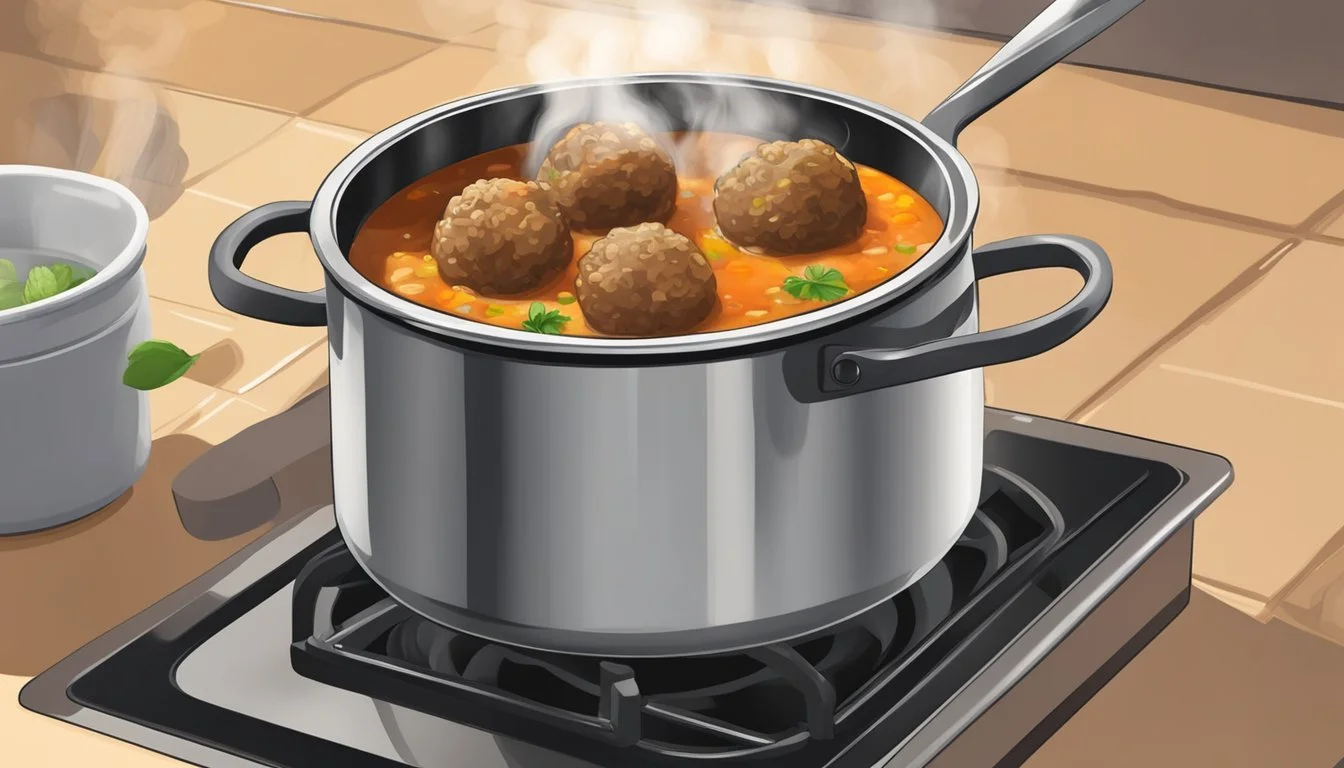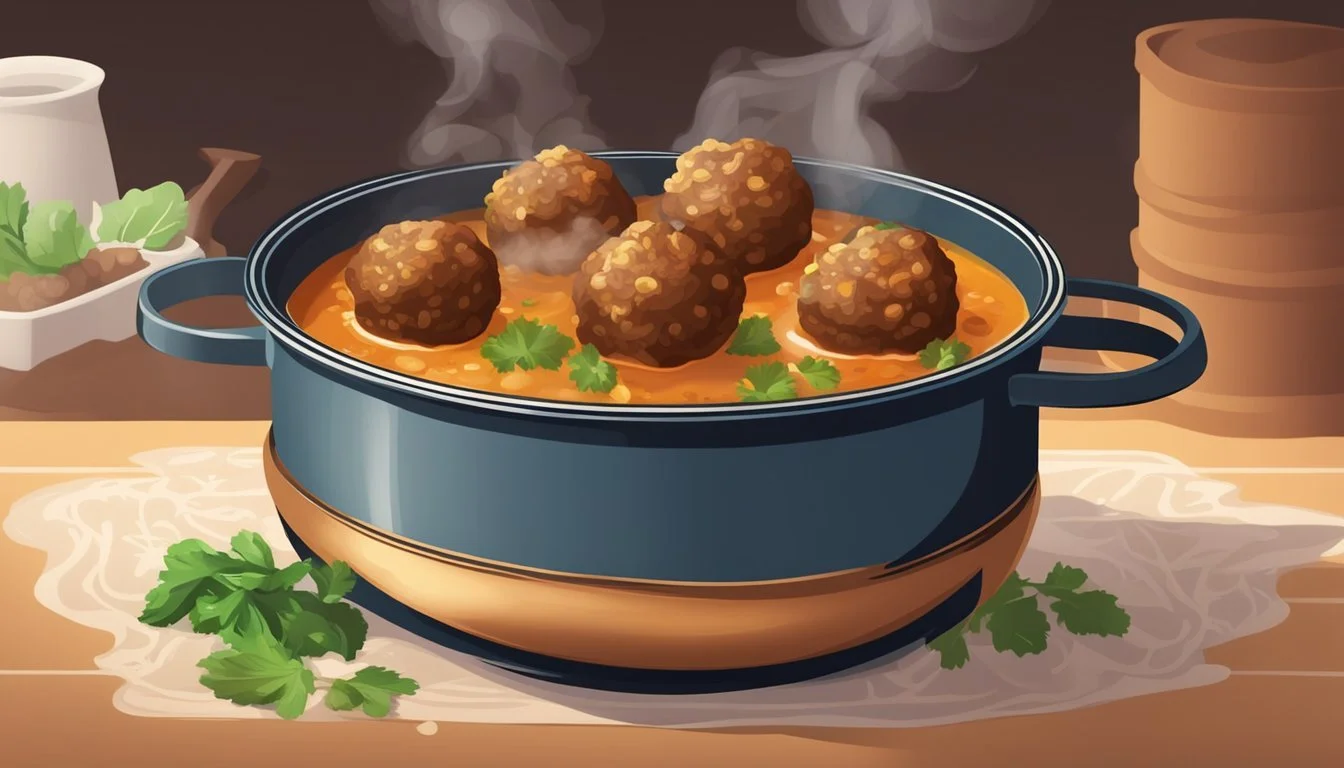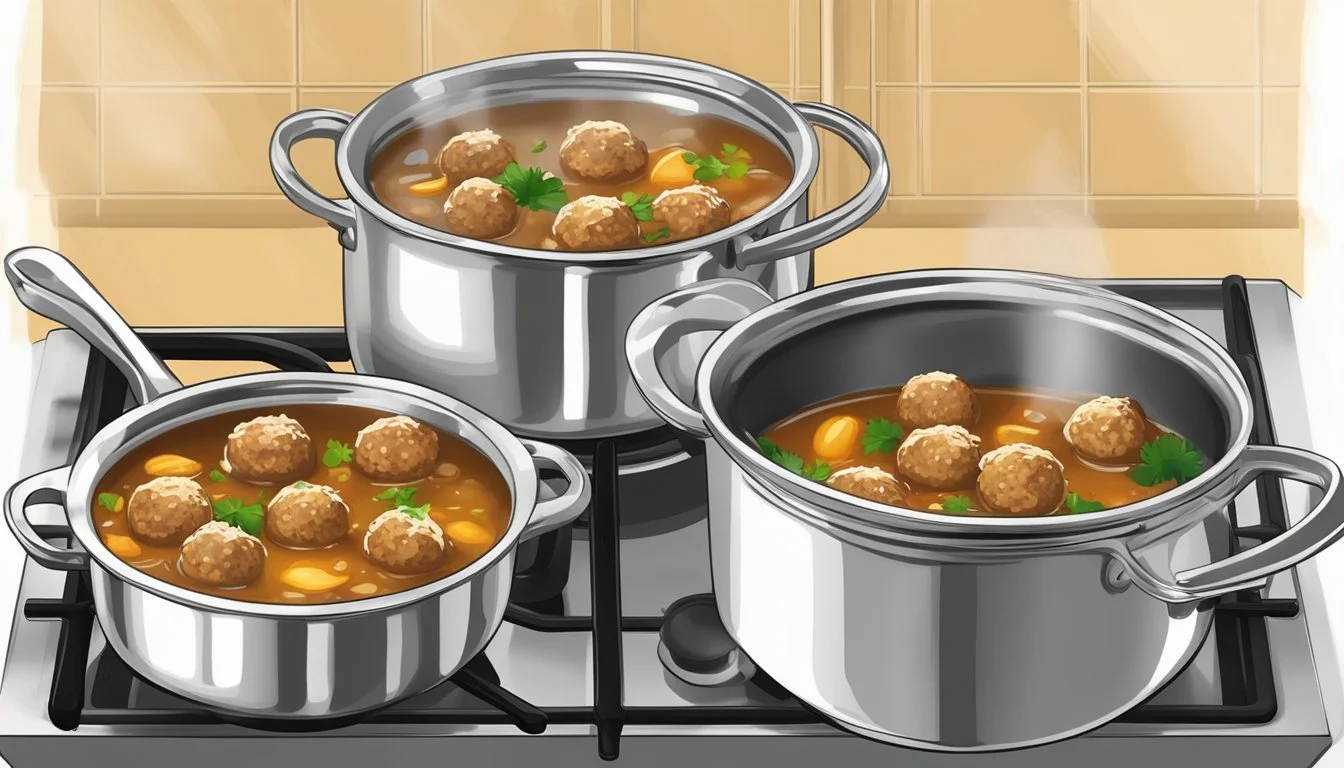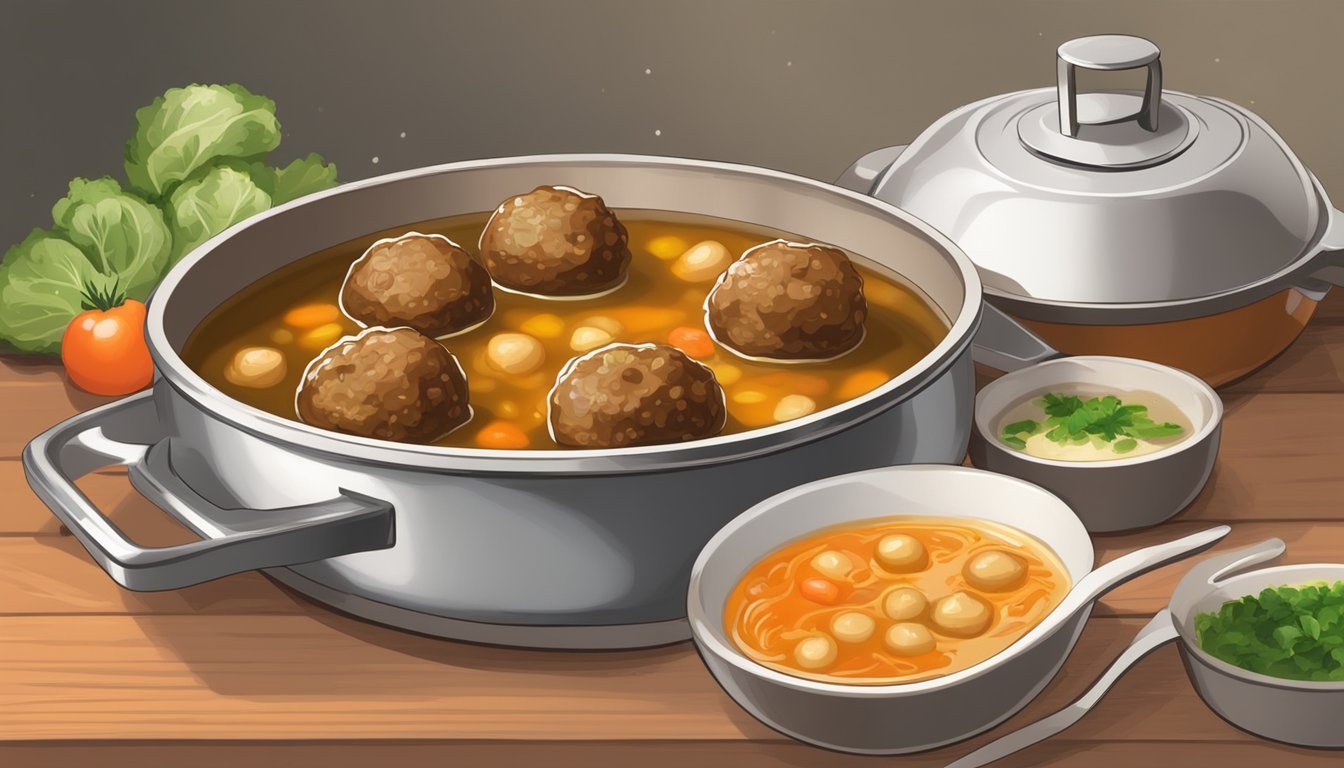Best Way to Reheat Albondigas Soup
Ensuring Tender Meatballs Every Time
Albondigas soup, a traditional Mexican meatball soup, is a comforting and flavorful dish known for its rich broth and hearty meatballs. When it comes to reheating this soup, the key is preserving the tenderness of the meatballs while ensuring the soup is heated through. Since the meatballs are the stars of the dish, it's crucial to employ a method that avoids overcooking them, which can result in a rubbery texture that detracts from the soup's overall appeal.
Achieving the right temperature and consistency in reheated albondigas soup can be a delicate balance. The process needs to be gentle enough to warm the soup without compromising the succulence of the meatballs. The broth, typically infused with a blend of herbs and spices, acts as a protective medium for the meatballs, enveloping them in warmth and flavor as the temperature of the soup rises.
Maintaining the quality of albondigas soup when reheating involves paying careful attention to both time and temperature. It begins by choosing the appropriate reheating vessel and method that caters to a slow and even heat distribution. This not only helps in keeping the meatballs tender but also ensures that the soup's texture and flavor are restored to their original state.
Understanding Albondigas Soup
Albondigas Soup is a traditional Mexican meatball soup known for its robust flavor profile and hearty ingredients, offering a comforting and nutritious meal.
Essence of Albondigas Soup
The heart of Albondigas Soup lies in the harmonious combination of savory meatballs and a rich, flavorful broth. Typically, the meatballs are made from ground beef and rice, bound together with an egg and seasoned with a blend of traditional spices. The soup represents a staple in Mexican cuisine, celebrated for its comforting warmth and depth of flavor.
Common Ingredients
Key ingredients in Albondigas Soup include:
Meatballs: Made from a mix of ground beef, rice, and egg, and sometimes enhanced with finely chopped onion, tomato, or fresh herbs.
Broth: A savory broth serves as the base, often chicken or beef, and is seasoned with various spices such as cumin or chili powder to achieve a rich taste.
Vegetables: A variety of vegetables like carrots, potatoes, and sometimes other vegetables, are added, which not only impart flavor but also nutrition.
Nutritional Value
Albondigas Soup is a nutrient-rich option that typically includes:
Proteins: From both the beef and egg, providing structure and satiety.
Vitamins & Minerals: Abundant in the variety of vegetables such as carrots and potatoes.
Fiber: Found in the vegetables and rice, aiding in digestion.
This soup serves as a well-rounded meal, offering a balance of proteins, carbohydrates, and a variety of vitamins and minerals thanks to the diverse range of ingredients.
Preparing Meatballs for Reheating
To ensure meatballs maintain their tenderness when reheated, careful preparation of the ingredients and correct initial cooking and storage methods are crucial.
Meatball Ingredients and Mixing
For tender meatballs, select a blend of ground meats such as beef, pork, turkey, or chicken to create a balanced texture. A typical mixture might include:
Ground beef: 1/2 lb
Ground pork: 1/2 lb
Or use 1 lb of lean ground turkey or ground chicken as a healthier alternative.
Combine the meats with:
Egg: 1 large (as a binder)
Rice: 1/4 cup (for texture and to absorb flavors)
Onion: 1/4 cup, finely chopped
Garlic: 2 cloves, minced
Seasoning:
Salt: 1 tsp
Pepper: 1/2 tsp
Oregano: 1 tsp
Cumin: 1/2 tsp
Mix ingredients lightly to avoid overworking the meat, which can lead to tough meatballs.
Forming and Cooking Meatballs
After mixing, use a cookie scoop or hands to form the meat mixture into evenly sized balls — this ensures consistent cooking. To cook:
Fry meatballs in a pan over medium heat until browned and cooked through or;
Bake in a preheated oven at 400°F (200°C) for about 20 minutes.
Do not overcook; meatballs should be just firm to the touch, to remain tender upon reheating.
Cooling and Storing Freshly Made Meatballs
Allow the cooked meatballs to cool completely before storing to preserve their tenderness. Once cooled, they can be stored in the refrigerator for 3-4 days or in the freezer for up to a month. Store in an airtight container or zip-lock bag to prevent freezer burn and maintain moisture. If meatballs are in Albondigas Soup, store the soup and meatballs together to keep the meatballs moist.
Reheating Techniques
When reheating Albondigas Soup to maintain the meatballs' tenderness, one should pay attention to the method's heat control and timing. The goal is to warm the soup thoroughly without overcooking the meatballs.
Stovetop Reheating
For stovetop reheating, the individual should pour the leftovers into a large pot and set the heat to a low-medium setting. It's crucial to let the soup reach a simmer—not a boil—to avoid toughening the meatballs. During the process, stirring occasionally helps distribute the heat evenly. This method typically secures the meatballs' tenderness and ensures the soup reaches an adequate serving temperature.
Microwave Reheating
When reheating in a microwave, transferring the soup to a microwave-safe bowl is recommended. To reduce splattering and retain moisture, the bowl should be covered, perhaps with a microwave-safe lid. Heating on medium power in two-minute intervals, followed by careful stirring, allows the soup to heat evenly. This method suits those seeking a quick lunch without compromising the meatballs' texture.
Oven Reheating
Oven reheating can be another gentle method, particularly beneficial for large batches that may not fit in a pot or microwave. The soup should be placed in an oven-safe dish and covered with foil. Heating it at a low temperature, like 350°F, and checking periodically ensures that the soup warms evenly without drying out the meatballs. This approach takes longer but can yield leftovers that are nearly as tender and flavorful as when the soup was first prepared.
Preserving Soup Quality and Flavor
Maintaining the original taste and quality of Albondigas soup when reheating is crucial to enjoying its hearty and comforting flavors. Proper storage and reheating techniques can preserve both the soup's flavor and the tenderness of the meatballs.
Optimal Storage Practices
It is essential to cool the Albondigas soup quickly and store it properly to preserve its freshness. Storage tips include:
Transfer the soup to a shallow container and refrigerate within two hours of cooking.
Keep the soup in an airtight container to prevent it from absorbing other flavors from the refrigerator.
To freeze the soup, portion it into freezer bags or containers, leaving space to allow for expansion.
Impact of Reheating on Ingredients
Reheating can affect the Albondigas soup's ingredients, each responding differently to heat:
Vegetables like carrots and zucchini may become soft, so they should be slightly undercooked if the soup is to be reheated later.
Tomatoes, cilantro, and lime juice can lose their zest when overheated and should be added fresh when the soup is reheated.
Maintaining Meatball Tenderness
The tenderness of the meatballs in Albondigas soup is a highlight and preserving it requires gentle reheating:
Heat the soup on a stove over medium-low heat, stirring occasionally, until it reaches a gentle simmer.
Avoid boiling the soup vigorously as it can cause the tender meatballs to toughen and the ingredients to lose their flavor.
By following these practices, the Albondigas soup can retain its delightful blend of beef, chicken, and vegetables, ensuring that each reheated bowl is as flavorful and satisfying as when it was first prepared.
Serving and Garnishing
When serving albondigas soup, the choice of garnishes directly enhances the dish's flavors and influences how it's enjoyed. It's important to select garnishes that complement the tender meatballs and rich broth without overwhelming the palate.
Traditional Accompaniments
Tortillas: Warm, soft corn tortillas provide a traditional touch, perfect for wrapping or dipping into the soup.
Cilantro: Sprinkle fresh cilantro liberally to add a bright, herby note to the overall profile of the soup.
Lime wedges: The serve of a wedge of lime allows guests to adjust the acidity, uplifting the flavors of the meatballs and broth.
Rice: A side of rice is often enjoyed with albondigas soup, serving as a delightful base to soak up the savory broth.
Items to consider: Carrots and potatoes are already part of the soup, but offering extra on the side gives texture variety and a more filling option.
Creative Serving Suggestions
Avocado slices: Introduce slices of ripe avocado for a creamy element.
Sour Cream: A dollop of sour cream can add a nice tang and richness to the soup, melding harmoniously with the spices.
Fresh Herbs: Encourage the use of additional fresh herbs like dill or parsley to diversify the flavor profile beyond cilantro.
Chipotle or Kosher Salt: A sprinkle of chipotle powder offers a smoky touch, while a pinch of kosher salt can enhance the natural flavors of the veggies and meatballs.
Table of potential garnishes for personalization:
Garnish Flavor Profile Suggested Quantity Avocado slices Creamy, rich 2-3 per serve Sour Cream Tart, creamy 1 tablespoon Fresh Herbs Bright, aromatic A small pinch Chipotle Powder Smoky, spicy To taste Kosher Salt Salty, flavor-enhancing A pinch per bowl
By thoughtfully considering these traditional and creative serving suggestions, each bowl of albondigas soup can be personalized to the diner's preference, ensuring a warm and satisfying experience.
Advanced Tips and Variations
When reheating albondigas soup to maintain tender meatballs, it's essential to consider the meat variation, broth customization, and herb and spice enhancements for optimal flavor and texture.
Alternative Meat Variations
Different meats lend various levels of flavor and tenderness to albondigas soup. Chicken or turkey makes for a lighter version of the meatballs, while pork or beef provide a richer taste. For those seeking additional fiber and texture, mixing ground meats, such as combining pork and beef, can add depth. It's important to adjust cooking times accordingly: poultry should reach an internal temperature of 165°F, and mixtures of beef or pork should hit 160°F.
Chicken: lean, cooks quickly
Pork: rich flavor, combine with beef for complexity
Beef: traditional choice, robust taste
Customizing the Broth
The soul of albondigas soup is its broth, which can be crafted with either a tomato or chicken broth base. Enhancements like adding roma tomatoes or tomato sauce can intensify the tomato flavor, while a pinch of kosher salt can bring out the natural taste of the ingredients. For a heartier broth, consider incorporating finely diced carrots, celery, or corn along with traditional components like rice.
Chicken broth: classic foundation, use homemade or high-quality store-bought
Tomato broth: rich in flavor, use fresh roma tomatoes for bright acidity
Vegetable additions: Carrots, celery, corn, boost nutrition and taste
Herbs and Spices Enhancements
The right selection of herbs and spices can transform a simple albondigas soup into a gourmet experience. Oregano, cumin, and black pepper are essential seasonings, and mint or cilantro can provide a unique twist. To elevate the spice level, chili powder can be judiciously used, or fresh pepper diced for those who prefer a milder taste. Fresh herbs should be added towards the end of reheating to preserve their vibrant flavors.
Oregano: gives a peppery edge, use dried or fresh
Cumin: earthy note, start with ground cumin and adjust to taste
Cilantro/Mint: fresh, fragrant, add last to retain flavor
Chili Powder/Pepper: for a kick, use sparingly or to preference
Incorporating these advanced tips and variations into the reheating process will ensure that the meatballs remain tender and the albondigas soup is flavorful every time.
Long-Term Storage of Albondigas Soup
Proper storage techniques are vital for maintaining the flavor and tenderness of Albondigas soup meatballs when saving leftovers. Both freezing and refrigeration provide ways to preserve the soup, but each method has specific steps to ensure the best quality.
Freezing Albondigas Soup
Freezing is the best option for long-term storage of Albondigas soup. They should follow these steps to freeze the soup:
Cool the Soup: Allow the soup to cool to room temperature to prevent condensation and ice crystals from forming.
Portion the Soup: Divide the soup into meal-sized portions. This makes it easier to thaw only the amount needed later.
Airtight Containers: Transfer the portions into airtight containers or heavy-duty freezer bags to prevent freezer burn.
Label and Date: Mark the containers with the current date and the name of the soup for easy identification.
Freeze: Place in the freezer where the soup can retain quality for up to 2-3 months.
It's important not to include ingredients such as chayote in the soup before freezing, as their texture can change significantly when frozen and reheated.
Refrigerating for Short-Term Storage
For those who plan to eat their Albondigas soup within a few days, refrigeration is the suitable method. To refrigerate Albondigas soup:
Cool Down: Don’t leave the soup out at room temperature for more than two hours to avoid bacterial growth.
Airtight Container: Place the soup in an airtight container, which will keep it fresh and prevent it from absorbing other flavors from the refrigerator.
Use Timely: The soup should ideally be eaten within 3-4 days.
Reheating: Upon reheating, bring the soup to a rolling boil for at least one minute to ensure safety and restore the soup's flavors.
By adhering to these guidelines, one can enjoy Albondigas soup with the assurance that food safety and quality are prioritized.
Frequently Asked Questions
Reheating Albondigas Soup requires careful attention to maintain the tender texture of the meatballs and the rich flavor of the broth. This section covers common questions that arise when reheating this comforting dish, with easy-to-follow guidelines.
Common Queries About Reheating
Individuals often inquire about the best methods to reheat Albondigas soup while preserving its taste and texture. The recommended approach is a gentle reheat on the stove, over low to medium heat, stirring occasionally.
Meatball Troubleshooting
Concerns about meatballs include keeping them tender and preventing them from falling apart during reheating. One key tip is to ensure the soup reaches a simmer rather than a boil, as vigorous heat can cause meatballs to disintegrate.
Soup Storage Concerns
Queries regarding storage often touch on how to keep Albondigas Soup fresh for later enjoyment. Proper cooling and refrigeration within two hours of cooking is crucial for safety and quality. It's best consumed within three to four days when stored in airtight containers in the fridge.








